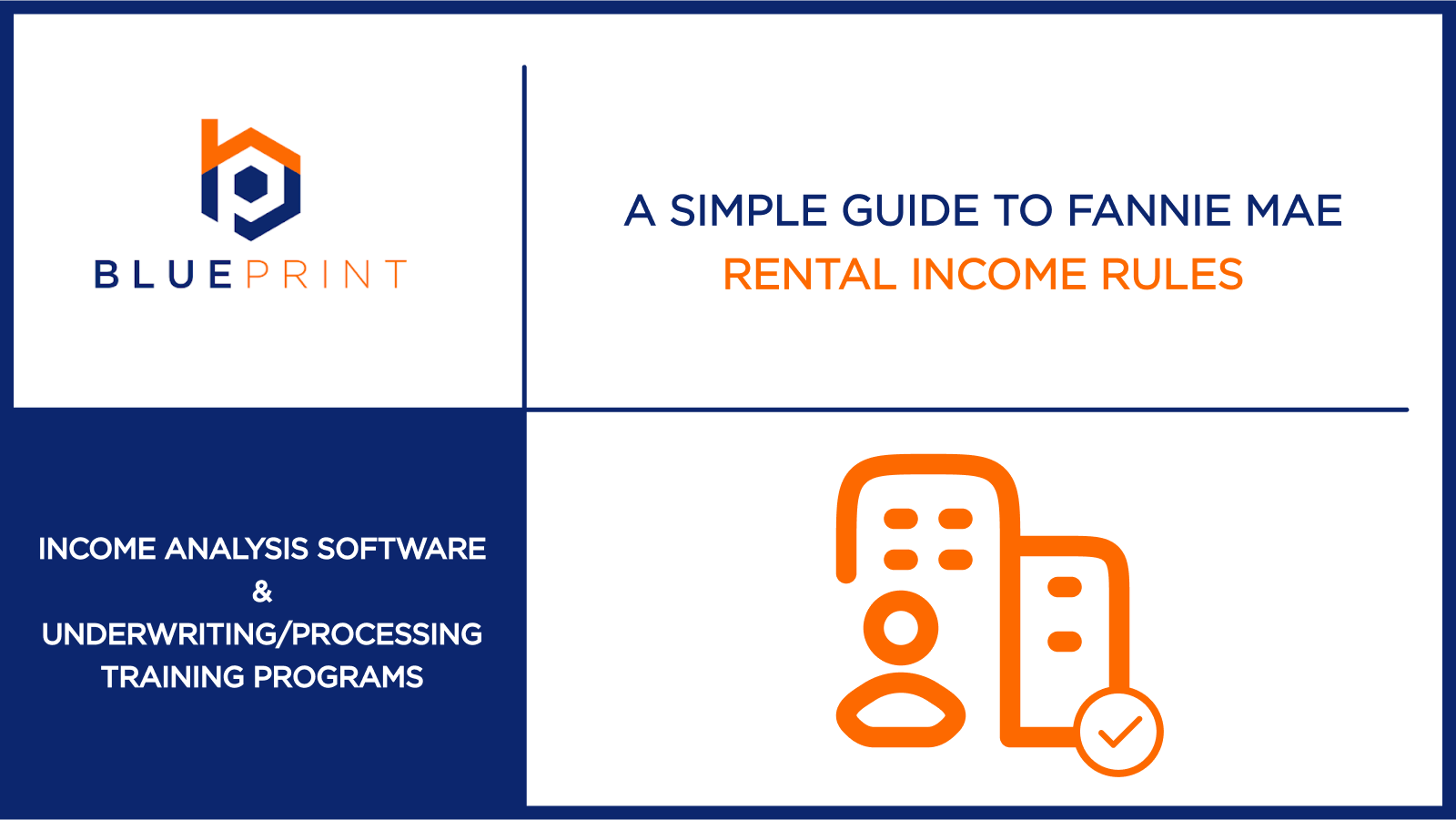Mortgage underwriting contains complex income qualification standards, especially for rental properties. Fannie Mae, as one of the nation’s leading mortgage purchasers, establishes specific guidelines that lenders must follow when evaluating rental income for mortgage qualification purposes.
These standards create consistency, accuracy, and proper risk assessment across the mortgage industry. Understanding these guidelines helps mortgage professionals manage the qualification process while reducing errors that could impact loan approval.
In this article, we will discuss the key rules and calculations lenders use to determine qualifying rental income, common mistakes to avoid, and how technology solutions can help make the process more efficient.
Main takeaways from this article:
- Fannie Mae has clear guidelines for qualifying rental income that vary by property type and ownership history.
- The 75% rule applies to lease-based rental income to account for vacancies and expenses.
- Specific calculation methods must be followed for Schedule E properties and new acquisitions.
- Technology solutions like IncomeXpert help maintain compliance and accuracy in rental income calculations.
Why Fannie Mae rental income rules matter

Fannie Mae’s rental income guidelines function as the mortgage industry’s standard for conventional lending. These rules directly impact loan salability, as mortgages failing to meet these standards become difficult to sell in the secondary market. In addition, income calculation errors rank among the top causes of costly repurchase demands.
Applying these guidelines correctly protects lenders while supporting qualified borrowers. Proper income qualification verifies borrowers can meet their mortgage obligations, and the uniform standards establish clear criteria for all parties involved in the lending process, reducing confusion and compliance issues.
Types of rental income recognized by Fannie Mae
Fannie Mae accepts various rental income types for mortgage qualification, each with its own rental income documentation standards. Below are the primary rental income sources it considers.
Schedule E rental income (for tax returns)
This type applies when the borrower has owned and rented a property long enough to report it on tax returns.
Documented through IRS Schedule E, this income reflects actual rental history, including gross rents, vacancy losses, operating expenses, and depreciation. It provides a reliable basis for calculating income used in mortgage qualification.
Lease agreement income
For properties recently acquired or not yet reported on tax returns, Fannie Mae allows the use of lease agreement income. Borrowers must provide a signed lease and proof of receipt, such as bank statements.
This income is typically subject to a vacancy adjustment and may not always be considered in full, depending on risk factors.
Rental income from multi-unit primary residences
If a borrower purchases or refinances a two-to-four-unit property and occupies one unit as their primary residence, rental income from the other units can count toward income. This is calculated using lease amounts or market rent (from an appraiser’s Form 1025), subject to specific percentage limits and underwriting rules.
Rules for rental income from existing rental properties

For properties owned by the borrower and rented before the mortgage application, Fannie Mae’s guidelines focus on documented performance rather than projections. The rules below outline how lenders evaluate income from existing rental properties.
The borrower must have a rental income history
To use existing property rental income, the borrower must show a history of managing and receiving income from these investments. This history establishes a performance pattern that underwriters use to predict future income.
Use Schedule E to calculate income
For existing rental properties, Schedule E from personal tax returns is the main documentation source. A one-year history is usually required. However, for properties that are short-term rentals, such as Airbnb, a two-year history is needed to demonstrate consistency.
The Schedule E calculation includes:
- Reported rental income
- Depreciation and depletion add-backs
- Non-recurring expenses and losses
- Documented property taxes and insurance
Documentation requirements
Standard documentation for existing rental properties includes:
- Complete personal tax returns with Schedule E for the required timeframe (typically one year).
- If the borrower does not have a history of renting the property or, in certain cases, if the tax returns do not accurately reflect the property’s ongoing income and expenses, a fully executed current lease agreement may be used.
These comprehensive documentation requirements help underwriters verify income consistency, validate current rental terms, establish legitimate ownership, and ensure proper income treatment for newer acquisitions.
Rules for rental income from new or recently acquired properties
Recently purchased properties or those without generated rental income require a different income qualification approach. To meet these requirements, lenders typically follow key documentation and calculation steps, outlined below.
Provide a lease showing gross monthly rent
For newly acquired rental properties, a fully executed lease agreement must establish the expected rental income. This lease should be current and signed by all parties. It should also clearly state the gross monthly payment amount and terms.
Show occupancy or rent received
Evidence that the property is occupied or rental payments have been received strengthens the case for using the income. This could include:
- Bank statements showing security deposit or first month’s rent deposits.
- Evidence of tenant occupancy through electronic transfers.
- Property management statements as additional documentation.
Apply the 75% rental income rule
Fannie Mae requires that only 75% of the gross rent from a lease be used to qualify for new rental properties. This reduction accounts for potential vacancies and maintenance expenses that have not been established through historical performance.
No qualifying income if not rented
Properties without current tenants or valid lease agreements cannot count projected rental income for qualification under Fannie Mae guidelines. This restriction prevents speculative income assumptions and requires borrowers to cover all expenses from other income sources, as the full PITIA payment counts against debt-to-income ratios without offsetting rental income.
How to calculate rental income under Fannie Mae guidelines

The method for calculating rental income varies depending on whether the property is an existing rental, a new acquisition, or part of the borrower’s primary residence.
1. Schedule E calculation (existing rentals)
For properties with a rental history reported on Schedule E, underwriters will typically average the net rental income (gross rents less operating expenses) over the most recent tax year filed. Depreciation, interest, insurance, and property taxes are typically added back to the net rental income. Additionally, the current PITI (Principal, Interest, Taxes, and Insurance) payment is subtracted from the rental income to provide a more accurate analysis of the property’s cash flow.
To calculate this, you may use the formula:
Monthly Rental Income = (Total Net Rental Income + Add-backs) / Number of Months in the Period – Current PITI
2. Lease-based income (new acquisitions)
When using a lease agreement for a new or recently acquired property, the calculation is done using the formula:
Effective Monthly Rental Income = Gross Monthly Rent × 75% – PITI
Common mistakes when calculating rental income

Even seasoned mortgage professionals can make mistakes when applying Fannie Mae’s rental income guidelines. Recognizing these common pitfalls helps prevent errors that may impact loan approvals or repurchase demands.
Using 100% of the lease income instead of 75%
One of the most common mistakes lenders make is failing to apply the required 75% vacancy and expense factor when using lease-based rental income. Relying on 100% of the lease amount inflates the borrower’s income, leading to overqualification and increased risk of loan defects or repurchase requests.
Forgetting to subtract PITIA
When calculating net rental income, the entire mortgage payment must be subtracted. Some processors omit certain components, such as association fees or insurance, which inflate income figures.
Misinterpreting Schedule E data
Schedule E contains many line items that require proper analysis. Common errors include failing to add back depreciation, missing non-recurring expenses that should be excluded, incorrectly averaging income when there is a declining trend for short term rental properties, and not accounting for properties that were in service for partial years.
Inconsistent averaging periods
With multiple years of tax returns available, inconsistent averaging leads to calculation errors. Lenders should refer to Fannie Mae’s guidelines on whether to average income or use the most recent year’s figures.
Missing or incomplete documentation
Incomplete documentation often causes income calculation errors. Missing leases, tax returns without all schedules, or insufficient evidence of rent received can compromise rental income accuracy.
How IncomeXpert helps prevent rental income mistakes
Rental income miscalculations frequently trigger loan defects and repurchase requests, creating financial and compliance risks for lenders. IncomeXpert addresses this challenge with specialized automation and verification tools that ensure accurate rental income assessment from the start.
- Automates complex calculations: IncomeXpert eliminates manual calculation errors by applying Fannie Mae rental income guidelines to borrower documentation. The system allows Schedule E calculations or lease-based methods, applies appropriate vacancy factors, and accounts for all property expenses.
- Flags documentation gaps: The platform identifies missing or inconsistent documentation before it becomes problematic. By cross-referencing guidelines and providing advisories, IncomeXpert alerts underwriters to discrepancies that could cause calculation errors or compliance issues if not considered.
- Standardizes income treatment: IncomeXpert applies Fannie Mae guidelines consistently across all loans and underwriters. The system uses the same methodology every time, eliminating the variability that occurs with manual calculations and interpretations.
- Generates audit-ready reports: Detailed income calculation reports document how rental income was derived. These audit-ready reports show exactly how Fannie Mae guidelines were applied, creating a record that can help prevent or address repurchase requests.
Simplify Fannie Mae income reviews with IncomeXpert
Calculating rental income according to Fannie Mae’s guidelines doesn’t have to be complex. IncomeXpert transforms this error-prone process into an automated workflow that increases accuracy, improves loan processing, and reduces repurchase risk.
By implementing IncomeXpert, mortgage lenders can cut underwriting time, reduce income calculation errors, maintain consistent compliance with Fannie Mae guidelines, create complete audit trails for every income calculation, and improve loan quality and scalability. So, don’t let rental income calculations put your loans at risk.
See how IncomeXpert can transform your underwriting process and uphold compliance with Fannie Mae rental income guidelines. Request a demo today!

